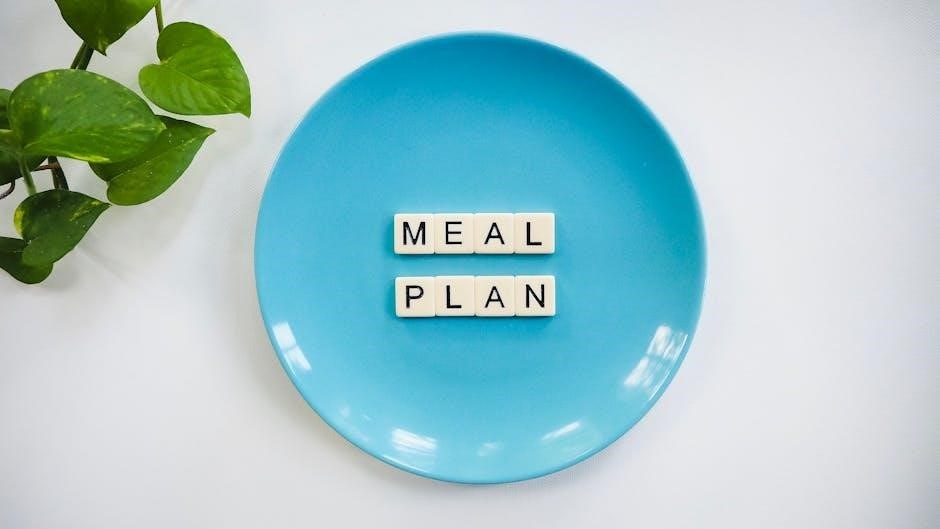
Metabolic Confusion Meal Plan: An Overview
A metabolic confusion meal plan, often found in PDF format, provides a structured approach to calorie cycling. This dietary strategy involves alternating between high and low-calorie days. This variation aims to prevent metabolic adaptation and promote continuous weight loss, offering a flexible approach.
What is Metabolic Confusion (Calorie Cycling)?
Metabolic confusion, also known as calorie cycling, is a dietary strategy that involves alternating between periods of high and low-calorie intake. The goal is to “trick” your metabolism, preventing it from adapting to a consistent calorie level. By varying your calorie intake, the body is thought to burn calories more efficiently, potentially leading to enhanced weight loss and improved metabolic function. A metabolic confusion meal plan PDF often outlines specific calorie targets for high and low-calorie days, along with sample meals. This approach contrasts with traditional dieting, where calorie restriction remains constant.
The Science Behind Metabolic Confusion and Metabolism
The science behind metabolic confusion centers on the body’s adaptive response to consistent calorie restriction. When you consistently consume fewer calories, your metabolism can slow down to conserve energy. Metabolic confusion attempts to circumvent this adaptation by introducing variability in calorie intake. This is believed to keep the metabolism guessing, preventing it from settling into a slower rate. The effectiveness of this approach is still debated, with some experts suggesting it’s based on a myth, while others report success. Metabolic confusion meal plan PDFs may claim to “boost” metabolism.
Key Components of a Metabolic Confusion Meal Plan
Key components involve calorie cycling, alternating between high-calorie and low-calorie days. Macronutrient manipulation is also crucial, balancing protein, carbs, and fats. These strategies aim to prevent metabolic adaptation and promote continuous weight loss effectively.
Calorie Cycling Strategies: High-Calorie vs. Low-Calorie Days
Calorie cycling is a cornerstone of metabolic confusion, alternating between high-calorie and low-calorie intake days. High-calorie days involve consuming around 2,000 calories or more, while low-calorie days restrict intake to approximately 1,200 calories. This variation aims to prevent the metabolism from adapting to a consistent caloric intake. By strategically manipulating calorie levels, the body is encouraged to burn fat more efficiently. The fluctuations in calorie intake are designed to “trick” the metabolism, preventing it from entering a plateau. This approach supports continuous weight loss. The specific calorie ranges can be adjusted based on individual needs and goals.
Macronutrient Manipulation: Balancing Protein, Carbs, and Fats
Macronutrient manipulation is integral to the metabolic confusion approach, involving strategic adjustments to protein, carbohydrates, and fat intake. A balanced intake, prioritizing protein and fiber-rich foods, supports satiety and boosts metabolism. On high-calorie days, carbohydrate intake may be increased to fuel activity, while on low-calorie days, protein intake is emphasized to preserve muscle mass. The precise ratios of macronutrients can be adjusted to align with individual preferences and fitness goals; Incorporating protein can help you feel full, for longer compared to a carb meal. Paying attention to macronutrient balance helps optimize the metabolic response to calorie cycling.

Foods to Include in Your Metabolic Confusion Meal Plan
A metabolic confusion meal plan emphasizes foods high in protein and fiber; Examples include lean proteins like chicken, turkey, or fish. These choices promote satiety and help boost metabolism, supporting weight loss goals.
Lean Proteins and Fiber-Rich Foods
When following a metabolic confusion diet, prioritizing lean proteins and fiber-rich foods is crucial for success. Lean proteins, such as chicken breast, turkey, fish, and eggs, support muscle maintenance and promote satiety. Fiber-rich foods, including vegetables, fruits, and legumes, aid in digestion, regulate blood sugar levels, and contribute to a feeling of fullness.
Incorporating these food groups into your meal plan ensures that you are getting essential nutrients while effectively managing your calorie intake. Legumes like beans and peas speed up the metabolic rate, and speed up the fat burning process, making them a good addition.
Foods Rich in Iron, Zinc, and Selenium
Incorporating foods rich in iron, zinc, and selenium is vital for overall health and metabolic function within a metabolic confusion meal plan. Iron-rich foods, like lean meats, spinach, and lentils, support energy production and oxygen transport. Zinc, found in seafood, nuts, and seeds, is essential for immune function and metabolism. Selenium, present in Brazil nuts, tuna, and eggs, acts as an antioxidant and supports thyroid health.
These nutrients play crucial roles in maintaining optimal bodily functions, enhancing the effectiveness of the metabolic confusion approach. Chilli peppers, coffee, and tea low in calories rev up your metabolism levels.

Sample Metabolic Confusion Meal Plan (7-Day)
A 7-day metabolic confusion meal plan offers a practical framework for implementing calorie cycling. These plans typically alternate between high and low-calorie days. This structure aids weight management by preventing metabolic adaptation and promoting consistent results.
Example High-Calorie Day Meal Plan
A high-calorie day within a metabolic confusion meal plan is designed to temporarily increase caloric intake. This strategy aims to prevent metabolic slowdown and encourage continued fat burning. For breakfast, consider an omelet with cheese, wheat bread, and bacon, accompanied by tea. Lunch could consist of bread, turkey, cheese, and lettuce, with a side of banana or dark chocolate. Dinner might feature spaghetti with chicken and broccoli. These choices provide a surplus of calories to counteract metabolic adaptation.
Example Low-Calorie Day Meal Plan
A low-calorie day in a metabolic confusion meal plan aims to create a caloric deficit, promoting weight loss. Breakfast options include low-fat Greek yogurt with raspberries and almonds. Lunch could be a muffin with pizza sauce and mozzarella. Dinner might consist of salmon, brown rice, broccoli, and teriyaki sauce. These choices provide fewer calories than usual to facilitate fat burning and weight loss. It’s important to maintain adequate protein intake and nutrient-rich foods even on low-calorie days to support overall health.
Metabolic Confusion for Endomorphs
Metabolic confusion can be adapted for endomorphs, who tend to have a higher fat mass. This approach involves adjusting calorie cycling and macronutrient ratios to suit their body type and promote fat loss effectively.
Adapting the Plan for Endomorph Body Types
For endomorphs, adapting the metabolic confusion meal plan involves careful consideration of macronutrient ratios and calorie cycling strategies. Given their tendency to store fat more readily, a higher protein intake is beneficial to support muscle mass and satiety.
Calorie cycling should be structured to include more frequent low-calorie days to promote fat burning. Emphasizing whole, unprocessed foods and limiting refined carbohydrates is crucial. Hydration is also key, and incorporating regular exercise, particularly HIIT, can enhance results by boosting metabolism and burning visceral fat. This tailored approach helps endomorphs effectively manage their body composition.
Vegetarian/Plant-Based Adaptations
Adapting a metabolic confusion meal plan for vegetarians and vegans requires careful planning to ensure adequate protein intake. Plant-based protein sources like legumes, lentils, tofu, tempeh, and quinoa should be strategically incorporated, focusing on variety to obtain all essential amino acids.
Calorie cycling can be maintained using high-calorie days with healthy fats from avocados and nuts. Low-calorie days can feature abundant non-starchy vegetables and moderate portions of plant-based proteins. Supplementation with B12, iron, and omega-3 fatty acids may be necessary. Emphasize whole, unprocessed plant foods and monitor micronutrient intake to achieve optimal health and weight management.

Combining Metabolic Confusion with Exercise
Combining a metabolic confusion meal plan with exercise, particularly HIIT, can enhance weight loss results. HIIT boosts calorie burning and targets visceral fat, complementing the diet’s cyclical approach to metabolism. This synergistic effect can optimize body composition.
The Role of HIIT (High-Intensity Interval Training)
High-Intensity Interval Training, or HIIT, plays a significant role in complementing a metabolic confusion meal plan. Engaging in HIIT workouts can further accelerate weight loss, particularly for endomorphs. The body’s response to the changing demands of HIIT results in increased calorie expenditure and efficient visceral fat reduction. Integrating HIIT into a metabolic confusion strategy can amplify the diet’s effects by providing a dynamic stimulus that prevents metabolic adaptation. This combination creates a powerful approach to fat burning and improved body composition, maximizing the benefits of both diet and exercise. The body reacts to new changes and burns more calories.
Potential Benefits and Drawbacks of Metabolic Confusion
Metabolic confusion offers potential benefits like short-term weight loss, by frequently alternating caloric intake. However, a significant drawback involves long-term sustainability. Maintaining precise calorie counts can be challenging, making adherence difficult and potentially unsustainable over extended periods.
Short-Term Weight Loss vs. Long-Term Sustainability
A metabolic confusion meal plan can yield rapid initial weight loss results, primarily by shocking the body into burning more calories. However, the diet’s long-term effectiveness is questionable. Maintaining a strict cycle of high and low-calorie days requires meticulous planning and consistent execution, which can be difficult for many individuals to sustain. Furthermore, the restrictive nature of the diet can lead to feelings of deprivation and ultimately, dietary burnout. While promising in the short run, long-term success depends on individual commitment and a sustainable approach to calorie management.

Considerations and Precautions
Before starting a metabolic confusion meal plan, consult a healthcare professional. Ensure adequate hydration and nutritional balance. This diet may not suit individuals with certain medical conditions or disordered eating tendencies, so proceed cautiously.
Hydration and Overall Nutritional Balance
Maintaining proper hydration is crucial while following a metabolic confusion meal plan. Adequate water intake supports metabolic processes and helps manage hunger. Prioritize a balanced intake of essential nutrients, including vitamins, minerals, and fiber. Focus on whole, unprocessed foods to ensure you’re meeting your nutritional needs.
Avoid restrictive eating patterns that could lead to deficiencies. Listen to your body’s hunger and satiety cues, adjusting your plan as needed. Be mindful of portion sizes and prioritize nutrient-dense foods. This approach will ensure that you are getting adequate nutrition and proper hydration.

